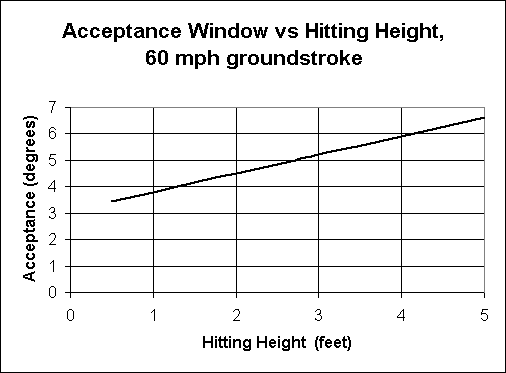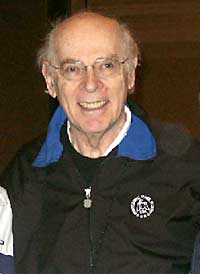|
TennisOne Lessons Windows of Acceptance II Howard Brody Tennis players frequently make unforced errors of depth. Too often their shots either hit the net or go long. Is there anything that they can do about this? YES. By understanding the idea of "Windows of Vertical Angular Acceptance" it might be possible to reduce the unforced errors of depth.
In the previous article, the concept of "Windows of Acceptance" was discussed. To be exact, it should be referred to as "Windows of Vertical Angular Acceptance," but that is too long a phrase to be using again and again, so it will be called either just "window" or "acceptance" for the rest of this article on this subject. Let us review the concept presented in the previous article. In order for a shot to be good, it must cross above the net and bounce within the court. Once you specify the initial ball conditions (spin, velocity, impact height, horizontal angle, where you are on the court, etc.) there is a certain minimum vertical angle off the racquet the ball must have to clear the net. There is also a certain maximum vertical angle the ball can have and still land in the court. If a shot hit with these initial conditions is to be good, its initial angle off the racquet must be between this minimum and maximum angle. If the initial angle off the racquet is below the minimum, the ball will end up in the net. If the initial angle of the ball is above the maximum, the ball will sail long. The difference between the maximum angle and the minimum angle is the angular acceptance for a particular shot. This difference is plotted against the initial ball speed in Figure 1 (which is Figure 3. of the previous article). It is very clear that you can increase your acceptance window (and because of that, make less unforced errors) by not hitting the ball as hard. However, this makes it easier for your opponent. Is there anything you can do to increase your acceptance and still hit aggressive shots? YES!
You can hit the ball when it is higher in its trajectory. You should move in or back to allow you to hit the ball when it is high. Don't let the ball fall down below your knees before striking it. Hit it at as high an impact point as you can be comfortably doing it. The higher the impact point, the bigger the window. This is shown in Figure 2.
Note; by hitting the ball when it is 4 feet above the court, your acceptance window is 50% larger than if you hit exactly the same shot when the ball is one foot above the ground. The bigger the window, the less likely you are to make an error of depth. This is also why hitting shots on the rise and also half-volleys are less likely to go in. To keep your unforced error rate low, don't let the ball fall down too low before you hit it. Your position on the court can also influence your acceptance window. For a groundstroke, the further behind the baseline you are when you hit the ball, the bigger your window (for shots hit at about waist height). The further inside the baseline you are, the smaller is your acceptance window. This is shown in Figure 3. This is not a big effect and it is probably counterbalanced by the fact that when you retreat well behind the baseline you are giving your opponent more time to get to and return your shots.
The biggest effect on the window of acceptance is due to the spin you put on the ball. Figure 4 shows how the acceptance depends on spin for both a 60 and 75 mph shot. Topspin adds another force (the Magnus force) to the force of gravity and pushes the ball down, making it bounce within the court. If you put 60 revolutions per second of topspin on the ball, you have almost doubled the window of acceptance compared to a flat shot at 60 mph and more than tripled the window at 75 mph. The window for a 75 mph shot hit with 40 rev/sec topspin is the same as the window for a flat 60 mph shot. It is clear, if you want to hit the ball hard and have it still go in, hit with a lot of topspin. With topspin, the ball will cross the net and dive into the court. The more topspin you hit with, the bigger is your window of acceptance. It all seems too easy, but it is not so easy to hit with big topspin — however, that is another article.
On the basis of Figures 2, 3, and 4, you now can see why some of the "dirt ballers" on the red clay at the French Open can stand well behind the baseline, hitting the ball at chest height, and whale away with tremendous topspin and pace, yet seemingly never making an error. Their window of acceptance is huge. Your comments are welcome. Let us know what you think about Howard Brody's article by emailing us here at TennisONE.
Professor Brody is a member the International Tennis Federation Technical Commission, the USTA Sports Science Committee, USTA Technical Committee, science advisor to the Professional Tennis Registry, technical advisor to the United States Racquet Stringers Association, on the Editorial Board of the Journal of Sports Engineering, and on the technical advisory panel of Tennis Magazine. His book Tennis Science for Tennis Players was published by the University of Pennsylvania Press in 1987. He and Vic Braden are featured in a video "The Science and Myths of Tennis." As one of the principal authors who have written an NSF sponsored high school physics course (Active Physics), he was responsible for the chapters dealing with the physics of sports. He has received the USPTR Plagenhoef award for sports science in 1996 and the International Tennis Hall of Fame Educational Merit Award for the year 2000. His latest book, The Physics and Technology of Tennis, written with Rod Cross and Crawford Lindsey was published in late 2002. He is also one of the principal authors of the CD-ROM on The Science of Tennis funded by the Lawn Tennis Association Coach Education. At the 2003 Tennis Science and Technology Congress, the ITF gave a prize for the best paper presented and named it the "Howard Brody Award" for his service to tennis. |





 Dr. Howard Brody is an emeritus professor of physics at the University of Pennsylvania , where he was interim varsity tennis coach for part of the 1991 season. He played varsity tennis and earned his bachelor's degree at MIT and his master's and doctoral degrees at Cal Tech. Recently he has been investigating the physics of sports, particularly tennis. He has written many papers and articles on the subject, given numerous lectures and talks on tennis, and done several television programs explaining the science behind tennis, football, and baseball.
Dr. Howard Brody is an emeritus professor of physics at the University of Pennsylvania , where he was interim varsity tennis coach for part of the 1991 season. He played varsity tennis and earned his bachelor's degree at MIT and his master's and doctoral degrees at Cal Tech. Recently he has been investigating the physics of sports, particularly tennis. He has written many papers and articles on the subject, given numerous lectures and talks on tennis, and done several television programs explaining the science behind tennis, football, and baseball.